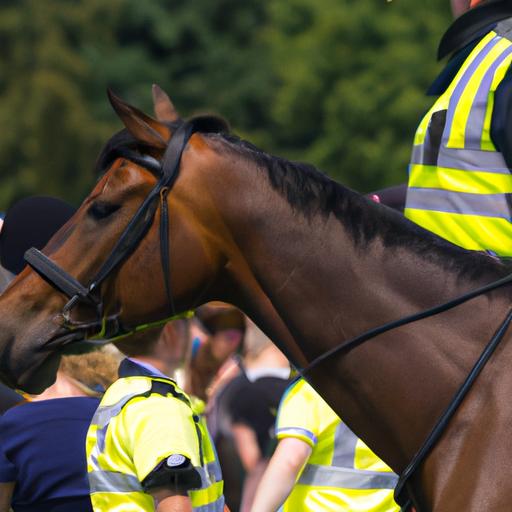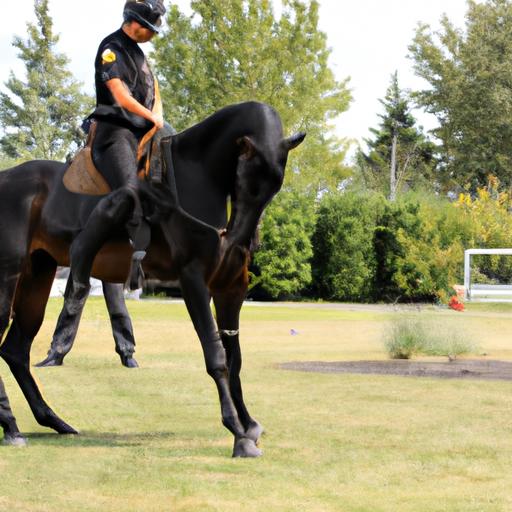Enhance law enforcement with effective police horse training techniques. Learn about desensitization, obedience, and mounting skills for these noble creatures.
Introduction

Imagine a bustling city center, teeming with people, traffic, and potential chaos. How do law enforcement agencies effectively maintain order in such a dynamic environment? One answer lies in the remarkable world of police horse training. In this article, I will delve into the intricacies of this specialized training, highlighting its significance in modern law enforcement.
What is police horse training?
Police horse training involves teaching horses and their riders the skills necessary to navigate through urban landscapes, manage crowds, and assist in various law enforcement operations. These majestic animals undergo rigorous training to become reliable partners in maintaining public safety.
Importance of police horse training in law enforcement
Law enforcement agencies around the world recognize the invaluable contributions of trained police horses. These magnificent creatures offer numerous advantages in urban policing scenarios. They possess an unparalleled vantage point, towering above the crowd, enabling officers to survey large areas swiftly. Moreover, their mere presence often deters potential disturbances, diffusing tense situations and promoting a sense of security.
Police horse training not only enhances crowd control but also fosters positive community relations. These magnificent animals act as ambassadors, bridging the gap between law enforcement and the public. Their gentle nature and approachability help break down barriers, allowing officers to engage and build trust with community members.
In the next section, we will explore the various benefits that police horse training brings to law enforcement. So, saddle up and let’s dive in!
Benefits of Police Horse Training

Law enforcement agencies have recognized the myriad benefits that police horse training brings to their operations. From enhanced crowd control to fostering positive community relations, the advantages are undeniable.
Enhanced crowd control and public safety
When it comes to managing large crowds during events or protests, police horses are an invaluable asset. Their imposing presence can de-escalate tense situations simply by their appearance, acting as a visual deterrent. Moreover, their size and maneuverability allow officers to navigate through dense crowds with greater ease, ensuring the safety of both the public and law enforcement personnel.
Heightened visibility and mobility in urban areas
In the concrete jungles of urban areas, police horses provide law enforcement officers with an elevated perspective, granting them a clear view of their surroundings. From this advantageous vantage point, officers on horseback can quickly identify potential threats, monitor the crowd, and respond promptly to any emerging issues. Additionally, horses possess the agility to navigate through crowded streets and narrow alleyways that might be inaccessible to traditional police vehicles.
Building trust and positive community relations
One of the most remarkable aspects of police horse training is its ability to forge positive relationships between law enforcement and the communities they serve. Horses naturally draw people’s attention and curiosity, acting as a conversation starter between officers and the public. This interaction helps break down barriers, allowing officers to establish trust, gather information, and foster a sense of cooperation. The presence of police horses in community events and patrols creates a friendly and approachable image of law enforcement, strengthening the bond between the police and the people they protect.
Stay tuned as we delve deeper into the training techniques employed in police horse training in the next section. We will explore how these magnificent animals are prepared to tackle the challenges they face on the job.
Advanced Police Horse Training Techniques

Law enforcement officers and their equine partners must undergo advanced training to effectively navigate complex scenarios and respond to potential threats. Let’s explore some of the key techniques involved in this advanced training.
A. Maneuvering through obstacles and narrow spaces
In urban environments, police horses must navigate through various obstacles and tight spaces with precision and grace. Training programs focus on developing the horse’s agility and spatial awareness, enabling them to maneuver through crowded streets, narrow alleyways, and other challenging terrain. By mastering these skills, police horses become invaluable assets in swiftly accessing areas where traditional law enforcement vehicles may struggle to reach.
B. Crowd management and reacting to potential threats
One of the crucial aspects of advanced police horse training is crowd management. These majestic animals are trained to remain calm and composed amidst large gatherings, ensuring the safety of both officers and the public. They learn to maintain a strong presence while responding appropriately to different crowd dynamics. From peaceful demonstrations to potentially volatile situations, police horses are trained to assess threats, de-escalate tension, and assist officers in maintaining order.
C. Collaboration with mounted police officers
Advanced police horse training also emphasizes effective collaboration between the horse and their mounted police officer. The officer and the horse develop a deep understanding and trust, working together seamlessly to execute complex maneuvers and respond to rapidly changing situations. Through continuous training and practice, both the horse and the rider become a cohesive unit, relying on each other’s cues and instincts to navigate challenging law enforcement scenarios.
As we explore the physical conditioning and health maintenance aspect of police horse training in the next section, we will delve into how these magnificent creatures are kept in optimal shape to perform their duties.
Physical Conditioning and Health Maintenance
A well-maintained and healthy police horse is a reliable partner in law enforcement. In this section, we will explore the essential aspects of physical conditioning and health maintenance that contribute to the overall well-being of these magnificent animals.
A. Regular exercise routines for police horses
Just like humans, horses require regular exercise to stay fit and maintain their physical stamina. Law enforcement agencies prioritize providing their equine partners with structured exercise routines. These routines encompass a variety of activities such as trotting, cantering, and galloping. The combination of these exercises helps develop the horse’s cardiovascular endurance, strength, and agility.
Regular exercise also plays a crucial role in desensitizing police horses to potential stressors they may encounter on duty. By exposing them to various environments and stimuli, such as different terrains, traffic, and loud noises, horses become more confident and adaptable, ensuring their readiness for any situation.
B. Proper nutrition and diet guidelines
A balanced and nutritious diet is vital for maintaining the optimal health of police horses. Law enforcement agencies work closely with equine nutritionists to develop appropriate feeding plans tailored to meet the specific needs of these remarkable animals. The diet typically consists of high-quality hay, grains, and supplements to provide necessary vitamins, minerals, and proteins.
Hydration is equally important, especially during demanding and high-intensity operations. Access to fresh and clean water is essential to prevent dehydration and maintain the horse’s overall well-being.
C. Veterinary care and preventive measures
To ensure the long-term health and well-being of police horses, routine veterinary care is essential. Regular check-ups, vaccinations, and dental examinations are conducted to monitor their health and address any potential issues promptly. Preventive measures, such as deworming and hoof care, are also implemented to maintain the horse’s overall condition.
Additionally, law enforcement agencies prioritize the implementation of safety measures to protect their equine partners. Protective gear, such as leg boots and reflective vests, are utilized to minimize the risk of injury during operations.
By prioritizing physical conditioning and health maintenance, law enforcement agencies ensure that their police horses remain in peak condition, enabling them to perform their duties effectively and safely.
In the next section, we will conclude our exploration of police horse training and its significance in modern law enforcement.
Conclusion
In conclusion, police horse training plays a vital role in modern law enforcement, offering numerous benefits and advantages. From enhanced crowd control and increased visibility to fostering positive community relations, these majestic animals have proven to be invaluable assets to law enforcement agencies worldwide.
As we have explored throughout this article, police horse training encompasses various techniques aimed at equipping horses and their riders with the necessary skills to navigate challenging urban environments. From desensitization to loud noises and unfamiliar surroundings to obedience and responsiveness to commands, every aspect of their training is meticulously designed to ensure their effectiveness on the field.
At Horsemasterypro.com, we understand the significance of police horse training in maintaining public safety and building trust within communities. We are dedicated to providing comprehensive resources and training programs that empower law enforcement agencies and their equine partners.
So, whether you are a law enforcement professional interested in incorporating horses into your operations or a horse enthusiast looking to learn more about police horse training, remember that Horsemasterypro.com is here to support you on your journey.
Together, let’s continue to champion the excellence of police horse training and its indelible impact on law enforcement.
Bolded: Horsemasterypro.com


